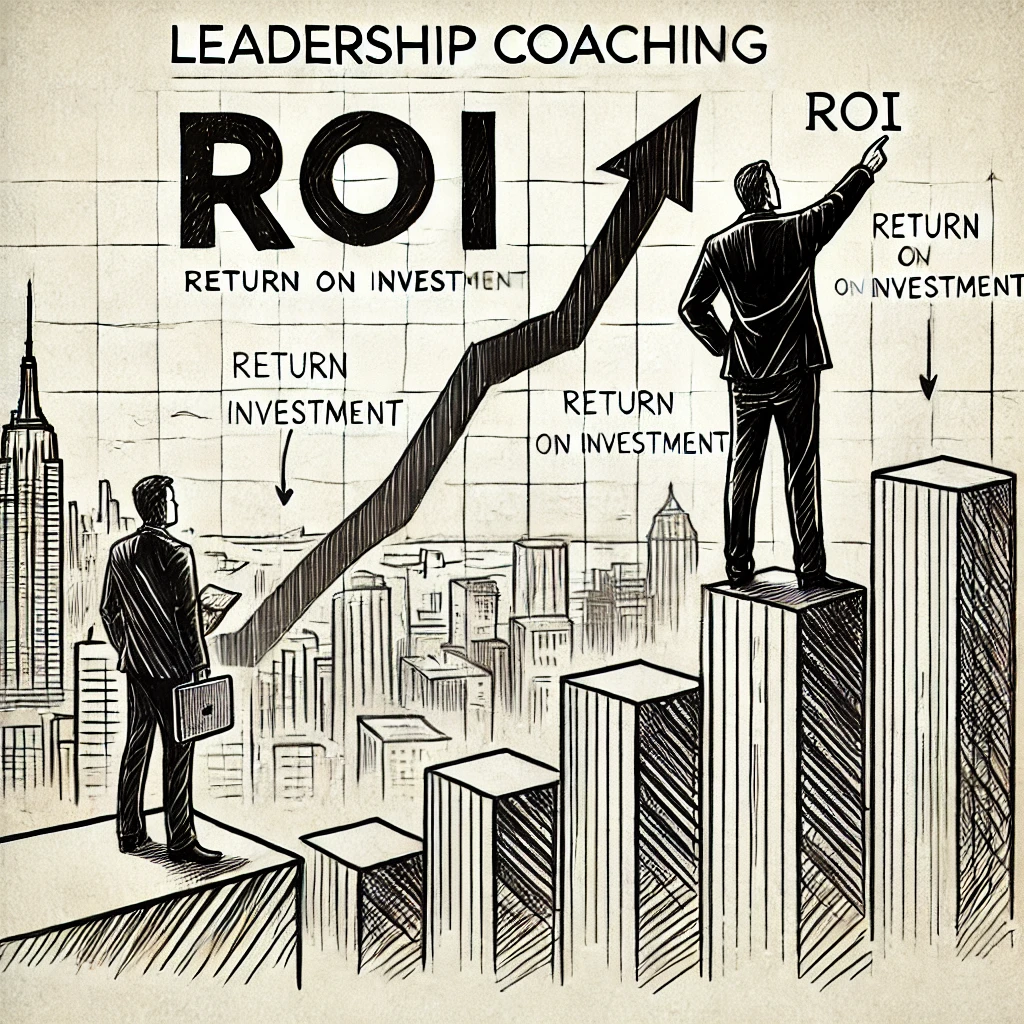Measuring Leadership Coaching ROI for Organizational Success
 Leadership coaching ROI is a hot topic for businesses today. Investing in leadership development can lead to significant gains. Companies often see improved team performance and higher employee engagement as a direct result of effective coaching. This boost not only enhances productivity but also drives profitability. Leaders with the right skills create a positive work culture that attracts top talent. The benefits extend beyond the workplace, impacting overall business growth. Understanding how to measure this ROI is crucial for making informed decisions about coaching programs. Discover how leadership coaching can transform your organization and maximize your investment.
Leadership coaching ROI is a hot topic for businesses today. Investing in leadership development can lead to significant gains. Companies often see improved team performance and higher employee engagement as a direct result of effective coaching. This boost not only enhances productivity but also drives profitability. Leaders with the right skills create a positive work culture that attracts top talent. The benefits extend beyond the workplace, impacting overall business growth. Understanding how to measure this ROI is crucial for making informed decisions about coaching programs. Discover how leadership coaching can transform your organization and maximize your investment.
Key Takeaways
Leadership coaching can significantly enhance personal and team performance, making it a worthwhile investment for organizations seeking growth.
To measure coaching’s ROI, focus on clear metrics such as employee engagement, productivity, and retention rates that reflect the coaching’s impact.
Building a coaching culture within your organization encourages continuous learning and development, which can lead to higher overall performance.
To maximize the benefits of coaching programs, implement high-return coaching strategies, such as setting specific goals and providing regular feedback.
Be aware of potential challenges in implementing coaching initiatives, such as resistance to change or lack of resources, and plan accordingly.
Stay informed about trends in leadership coaching to adapt your strategies and ensure ongoing effectiveness and relevance in your organization.
Understanding Leadership Coaching
Definition and Scope
Leadership coaching involves a structured relationship aimed at improving leadership skills. It is essential in organizational settings, where companies use it to develop leaders who can drive performance. Leadership coaching can occur in various contexts, including one-on-one sessions, group workshops, or even virtual meetings. The impact of coaching is significant. Individuals often gain self-awareness and confidence. Teams improve collaboration and productivity. Overall, effective coaching enhances both personal and organizational growth.
Key Components
Effective leadership coaching includes several key components. Communication is crucial for establishing a strong connection between the coach and the leader. Trust builds a safe environment for open discussions. Accountability ensures that leaders take responsibility for their development. Feedback plays a vital role in this process. Leaders receive constructive criticism to help them grow. Reflection allows individuals to think about their experiences. This combination fosters a deeper understanding of their leadership style.
Types of Leadership Coaching
Different types of leadership coaching serve distinct purposes. Executive coaching focuses on high-level leaders, helping them navigate complex challenges. Goals include strategic thinking and decision-making skills. Team coaching targets groups within organizations, enhancing teamwork and collaboration. This type promotes shared goals and collective problem-solving. Peer coaching involves colleagues supporting each other in their development journeys. It encourages mutual learning and accountability among peers.
Benefits of Leadership Coaching
Improved Performance
Leadership coaching leads to measurable performance improvements. Coaches help leaders identify their strengths and weaknesses. They focus on enhancing communication, conflict resolution, and team management skills. For example, a leader may learn to communicate more clearly, which can reduce misunderstandings in the team. This clarity boosts productivity.
Organizations see the results of improved performance. Teams become more efficient when leaders apply new skills effectively. A study by the International Coach Federation found that companies with leadership coaching reported a 70% increase in performance metrics. This improvement contributes directly to overall organizational success.
Enhanced Decision-Making
Coaching fosters better decision-making abilities among leaders. It encourages critical thinking and problem-solving skills. Leaders learn to analyze situations from multiple angles. They also develop strategies to address challenges effectively.
Diverse perspectives play a vital role in making informed decisions. Coaches encourage leaders to seek input from their teams. This collaborative approach leads to well-rounded solutions. For instance, a leader who engages team members in discussions can uncover valuable insights that enhance decision quality.
Increased Employee Engagement
Leadership coaching significantly contributes to higher levels of employee engagement. Engaged employees are more productive and have better morale within teams. They feel valued when leaders invest in their development through coaching.
Leaders create a culture of engagement by modeling positive behaviors learned during coaching sessions. When employees see their leaders actively improving, they are inspired to do the same. According to Gallup, organizations with highly engaged teams experience 21% greater profitability than those with low engagement levels.
Measuring Coaching ROI
 Setting Clear Goals
Setting Clear Goals
Establishing clear and achievable goals is vital in the coaching process. Goals guide the direction of coaching efforts and ensure that the coaching aligns with the organization’s overall objectives. Without clear goals, it’s easy to lose focus and drift away from desired outcomes.
Utilizing SMART criteria can enhance goal formulation. SMART stands for Specific, Measurable, Achievable, Relevant, and Time-bound. Specific goals provide clarity. Measurable goals allow for tracking progress. Achievable goals keep expectations realistic. Relevant goals ensure alignment with organizational needs. Time-bound goals create a sense of urgency. Setting these types of goals increases the likelihood of successful outcomes.
Data Collection Methods
Collecting data on coaching effectiveness involves various methods. Both qualitative and quantitative data are important for assessing outcomes. Quantitative data provides numerical insights into performance improvements, while qualitative data offers deeper understanding through personal experiences and feedback.
Surveys are a common method for gathering data. They can capture employee satisfaction and the perceived value of coaching. Interviews allow for more detailed discussions about individual experiences. performance reviews provide concrete evidence of improvement over time. Combining these methods creates a comprehensive view of coaching effectiveness.
Analyzing Results
Analyzing the data collected from coaching initiatives is crucial for understanding impact. This process involves looking for trends and patterns that indicate success or areas needing improvement. Identifying these patterns helps organizations see the real value of their investment in coaching.
Ongoing analysis is necessary to refine coaching approaches. Regularly reviewing results allows organizations to adapt their strategies as needed. This adaptability ensures that coaching remains relevant and effective over time. Continuous assessment also helps recognize new areas for development.
Metrics for Coaching Effectiveness
Performance Metrics
Key performance metrics measure the effectiveness of coaching. Organizations often use metrics like productivity, revenue growth, and employee satisfaction. Aligning these metrics with organizational goals is crucial. This ensures that coaching efforts support the overall mission. For example, tracking revenue growth becomes essential if a company aims to increase sales.
Productivity can be measured through output per employee. Increased productivity often reflects successful coaching. Employee satisfaction surveys offer insights into the workforce’s morale. Positive feedback indicates that coaching has improved workplace dynamics.
Behavioral Change Indicators
Specific behaviors indicate successful coaching outcomes. Leaders may display enhanced decision-making skills or improved communication. Observing changes in leadership styles is vital for assessing progress. For instance, leaders might become more inclusive or collaborative after coaching.
Measuring these changes requires feedback from peers and team members. Self-awareness plays a significant role in effective leadership. Coaches help leaders recognize their strengths and weaknesses. Adaptability also matters; leaders must adjust their styles based on team needs.
Employee Retention Rates
Effective leadership coaching is closely related to improved employee retention rates. A good leader creates a supportive work environment, which fosters loyalty among employees. When workers feel valued, they are less likely to leave.
Retaining talent saves organizations money in the long run. The cost of recruiting new employees can be high, and training new hires takes time and resources. By investing in leadership coaching, companies can create stable teams and reduce turnover.
Building a Coaching Culture
Leadership Commitment
Leadership commitment is crucial for successful coaching outcomes. Leaders must show their support for coaching initiatives. Visible backing from top management enhances the credibility of coaching programs. When leaders actively participate, they model the behaviors they wish to see in others. This participation builds trust and encourages employees to engage fully in the coaching process.
Leaders should also clearly communicate their vision for coaching. They need to set expectations and demonstrate how coaching aligns with organizational goals. This clarity helps everyone understand the value of coaching. It can lead to higher engagement and improved performance across teams.
Training Programs
The relationship between leadership coaching and formal training programs is significant. Coaching complements traditional training methods. While training offers essential skills and knowledge, coaching provides personalized support tailored to individual needs. This combination maximizes learning opportunities for leaders.
Integrating coaching into ongoing professional development is vital. Organizations should not treat coaching as a one-time event. Instead, it should be part of a broader strategy for continuous improvement. Regularly scheduled sessions can help reinforce lessons learned during formal training. This integration ensures that leaders can apply new skills effectively in real-world situations.
Continuous Feedback
Continuous feedback plays an essential role in the coaching process. Regular feedback loops enhance leaders’ learning and growth. Feedback allows individuals to understand their strengths and areas for improvement, fostering a growth mindset among team members.
Encouraging a culture of open communication is necessary for effective feedback. Leaders should create environments where team members feel comfortable sharing their thoughts. An open dialogue helps clarify expectations and promotes accountability. It also enables coaches to adjust their approaches based on feedback received from coachees.
Overall, building a coaching culture involves leadership commitment, effective training programs, and continuous feedback mechanisms. These elements work together to create an environment where leaders can thrive.
High ROI Coaching Strategies
Personalized Coaching Plans
Tailoring coaching plans to individual needs is essential. Each leader has unique strengths and areas for improvement. A personalized approach leads to more effective coaching outcomes. When coaches understand specific goals, they can create targeted strategies. Assessments play a crucial role in this process. They help identify skills and gaps in knowledge. This data informs the development of coaching plans. Using tools like 360-degree feedback can provide valuable insights. These insights guide the coach in customizing the experience.
Regular Progress Reviews
Conducting regular progress reviews is necessary for successful coaching. These reviews help track development over time. Coaches can assess what strategies work and which do not. Adjusting coaching methods based on these evaluations keeps the process relevant. Accountability remains critical in maintaining coaching momentum. Leaders who know they will report progress tend to stay engaged. This structure fosters commitment and encourages growth. Setting specific milestones during the coaching journey enhances focus.
Leveraging Technology
Technological tools can significantly enhance leadership coaching efforts. Virtual coaching platforms increase accessibility for participants. Leaders can connect with coaches from anywhere, reducing geographical barriers. This flexibility allows for more frequent interactions and support. Data analytics also plays a vital role in tracking effectiveness. Coaches can analyze patterns in performance data over time. This information helps refine coaching strategies further. Using technology streamlines communication between leaders and coaches. It ensures that both parties remain aligned on goals and progress.
Challenges in Implementation
Resistance to Change
Resistance often arises during leadership coaching initiatives. Employees may fear the unknown or feel threatened by new approaches. This resistance can stall progress and diminish the effectiveness of coaching programs. To overcome this, leaders must communicate openly. Addressing concerns directly helps in building trust. Encouraging a growth mindset is also crucial. Leaders should promote the idea that change leads to personal and professional development. When participants see the benefits, they are more likely to engage fully.
Time Constraints
Time constraints pose a significant challenge for effective coaching. Busy schedules often limit opportunities for meaningful interactions, leading to rushed sessions that lack depth. To combat this, organizations should integrate coaching into existing workflows. Scheduling short, focused sessions can maintain quality while fitting into tight schedules. Prioritizing coaching as a valuable investment is essential. Leaders should recognize its importance in driving organizational success. Allocating dedicated time for coaching demonstrates a commitment to growth.
Measuring Intangible Benefits
Measuring the intangible benefits of leadership coaching is complex. Improvements in relationships and workplace culture may not show up in numbers. However, these aspects are vital for overall success. Stronger relationships foster collaboration and innovation. A positive workplace culture enhances employee satisfaction and retention. These factors contribute significantly to long-term organizational growth. Leaders should focus on these qualitative improvements alongside quantitative metrics. The long-term value of intangible benefits often outweighs immediate returns.
Future of Leadership Coaching ROI
Emerging Trends
Current trends shape the landscape of leadership coaching. Coaching practices have an increasing focus on diversity, equity, and inclusion. Companies now recognize that diverse leadership teams drive better results. Coaches are adapting their methods to support leaders from various backgrounds. This shift enhances understanding and collaboration within teams.
Another trend is the rise of coaching for remote and hybrid work environments. With more employees working from home, leaders face unique challenges. Coaching now addresses issues like team engagement and communication across distances. Coaches help leaders develop skills suited for virtual interactions. This adaptation ensures that coaching remains relevant in changing work settings.
Technological Innovations
Innovative technologies transform leadership coaching significantly. Artificial intelligence (AI) and machine learning enhance personalized coaching experiences. These technologies analyze individual leader behaviors and preferences. They provide tailored feedback and resources based on specific needs. As a result, leaders receive more relevant guidance, improving their effectiveness.
Virtual reality (VR) also shows potential in simulating real-world coaching scenarios. VR allows leaders to practice skills in a controlled environment. They can experience difficult conversations or decision-making situations without real-world consequences. This immersive training prepares leaders for high-pressure situations they may face in their roles.
Evolving Business Needs
Leadership coaching must adapt to meet evolving business needs. Companies today require agility and responsiveness in coaching approaches. Leaders face rapid changes in markets and technologies, and coaches must prepare them to pivot quickly when needed. This flexibility helps organizations remain competitive.
Continuous learning plays a crucial role in preparing leaders for future challenges. Organizations should foster a culture of ongoing development. Coaches can guide leaders in identifying areas for personal growth. This approach helps leaders stay ahead of industry trends and shifts.
Leadership Coaching ROI: Key Insights and Takeaways
Leadership coaching is more than a trend; it’s a powerful tool for driving growth and success in your organization. Understanding the ROI of coaching helps you make informed decisions that benefit your team and bottom line. You can enhance leadership skills and boost performance by implementing effective strategies and fostering a coaching culture.
Don’t underestimate the impact of investing in leadership coaching. The right approach yields measurable results and prepares your leaders for future challenges. Take action now—evaluate your current coaching practices and start reaping the benefits today. Your team’s success is just a coaching session away!
Frequently Asked Questions
What is leadership coaching?
Leadership coaching is a personalized development process aimed at enhancing a leader’s skills, decision-making, and overall effectiveness. It involves one-on-one sessions with a coach who provides feedback and strategies tailored to the leader’s specific challenges.
How can I measure the ROI of leadership coaching?
Measuring ROI involves comparing the financial benefits gained from coaching against its costs. Metrics such as improved productivity, employee retention rates, and enhanced team performance are commonly used to assess the impact of coaching.
What are some benefits of leadership coaching?
Leadership coaching offers numerous benefits, including increased self-awareness, improved communication skills, enhanced problem-solving abilities, and greater emotional intelligence. These improvements lead to better team dynamics and organizational success.
What metrics can indicate coaching effectiveness?
Key metrics include employee engagement scores, turnover rates, performance reviews, and achievement of specific business goals. Tracking these indicators helps gauge the effectiveness of leadership coaching initiatives.
How can I build a coaching culture in my organization?
To foster a coaching culture, encourage open communication, train leaders on coaching techniques, and integrate coaching into performance management processes. Recognizing and rewarding effective coaching practices also reinforces this culture.
What are high ROI coaching strategies?
High ROI strategies include setting clear objectives, focusing on skill gaps, utilizing feedback loops, and implementing follow-up sessions. Tailoring coaching to individual needs ensures maximum impact and return on investment.
What challenges may arise during implementation?
Common challenges include resistance to change, lack of buy-in from leadership, insufficient resources, and unclear objectives. Addressing these barriers early on can help facilitate a smoother implementation of leadership coaching programs.

